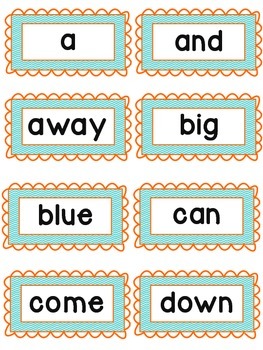
Sight words are the words that you will find on almost every page of a book. New to early literacy? Don’t worry! Learn the basics in our post, Supporting early literacy at homel What are sight words?

Wondering exactly when to introduce your child to high-frequency words? Keep reading! By Kindergarten, at approximately five years old, many kids are expanding their sight word recognition to words for higher digits, more colors, more pronouns, some prepositions, and common adjectives. A preschooler’s first 40 sight words generally include small numbers (one, two, three), primary colors (red, blue, yellow), and basic pronouns (me, we, you). Sight words are most commonly introduced at the preschool level when children are approximately four years old.
Sight words for pre k and kindergarten for free#
You can download the cards for FREE HERE.Is your little one getting ready to enter preschool or kindergarten? Then this is a great age to try teaching them sight words! They are a FREE download! These can be used on a word wall, flash cards, memory game (print 2 sets), Read the Room, Musical Words (see math examples here), ….so many ways to use them! Lastly, I wanted to share these PrePrimer word cards with y’all. You can find the PrePrimer Sight Word Readers HERE. Also, I like to laminate them so that we can use them for years to come! These could definitely be sent home as a homework reader. We read it daily during our school time and then I also have him read it one time at night. These include the same sentences as the ones inside the Interactive Books.

Something else we do each day is read this Sight Word Reader. You can find the PrePrimer Interactive books HERE. The sentences also only include sight words from the PrePrimer list. I really wanted to make sure that these sentences were ones that were developmentally appropriate for prek/kinder/or lower level 1st grade. Also, each sentence uses a decodable cvc word. Each sentence uses the sight word in context. They are all the sight word used in the book, just in different fonts/sizes.īuild It incorporates several skills: spelling, cutting, gluing, and fine motor. Match It: Students are practicing visual discrimination by identifying the match to the sight word. This incorporates spelling as well as letter formation, and tracing/fine motor.ĭay 3: (sometimes we break these two activities into 2 days) With Color It, students trace the letters in the word multiple times using a different color each time. This is also great for incorporating visual scanning which is a developmental skill that we are working on. Also, we look for any other words we have learned previously. We practice reading and identifying the word for the week. Some of the sight word books include shapes, number identification and formation, counting, and different representations of subitizing.
Sight words for pre k and kindergarten plus#
I love this Repeat It page because students are getting fluency practice plus math practice. Because I am doing preschool at home with his this year, I try to integrate as many different skills within 1 activity as I can. He reads the word and completes the math activity for each time he reads the word. Each day we will do 1 – 2 pages to practice that week’s word.Īfter I introduce the sight word for the week, we start off with the first 2 pages of these Interactive Sight Word Books. This of course could be done differently in your classroom this is just what works for us.

He is loving them and is doing so well recalling the words we have learned so far.Įach week we learn a new word.

Hello and happy Friday! I wanted to show you these PrePrimer sight word activities that I have been doing with my youngest.


 0 kommentar(er)
0 kommentar(er)
